| Contents
Home
General
Info
Ordering
Info
Cartridge
Lists
Patent & Miscellaneous
Rim Fire
Center Fire Pistol
Center Fire Rifle
Metric Rimfire,
Pistol&Rifle
British Pistol and Rifle
Shotgun Shells
Cartridge Boxes &
Related
Posters
This Month's Picture Page
Index to
Picture Pages
Prior Picture Pages:
*
September 2003
*
October 2003
*
November 2003
*
December 2003
*
January 2004
*
February 2004
*
March 2004
*
April 2004
*
May 2004
*
June 2004
*
July 2004
*
August 2004
*
September 2004
*
October 2004
*
November 2004
*
December
2004
*
January 2005
*
February
2005
*
March
2005
*
April
2005
*
May 2005
* June 2005
* July 2005
*
August 2005
*
September
2005
*
October 2005
*
November 2005
*
December 2005
*
January 2006
*
February 2006
*
March 2006
*
April 2006
*May 2006
*June 2006
*July 2006
*August
2006
*September
2006
*October
2006
*November
2006
*December
2006
*January
2007
*February
2007
*March
2007
*April
2007
*May
2007
*June
2007
*July
2007
*August
2007
*September
2007
*October
2007
*November
2007
*December
2007
*January
2008
*February
2008
*March
2008
*April
2008
*May
2008
*June
2008
*July
2008
*August
2008
*September
2008
*October
2008
*November
2008
*December
2008
*January
2009
*February
2009
*March
2009
*April
2009
*May
2009
*June
2009
*July
2009
*August
2009
*September
2009
*October
2009
*November
2009
*December
2009
*January
2010
*February
2010
*March
2010
*April
2010
*May
2010
*June
2010
*July
2010
*August
2010
*September
2010
*October
2010
*November
2010
*December
2010
*January
2011
*February
2011
*March
2011
There are no picture pages
for April thru June 2011
*July
2011
*August
2011
*September
2011
*October
2011
*November
2011
*December
2011
*January
2012
*February
2012
*March
2012
*April
2012
*May
2012
*June
2012
*July
2012
*August
2012
*September
2012
*October
2012
*November
2012
*December
2012
Links to Other Sites
Cartridge Collectors Organizations:
IAA
ECRA
SAAACA
Auctions:
Auction
Arms
E-Bay
Ward's Collectibles
Sold USA
Books:
Armory
Publications
WCF Publications
Other Collector's Sites:
Curtis Steinhauer
E-mail the Ammo Guy |
Home of the Old Ammo Guy's Virtual
Cartridge Trading Table
E-mail me at:
ammoguy@centurylink.net
Picture Page
January 2013
Ethan Allen's lip fire cartridges........
On August 5, 1854, Horace Smith
and Daniel B. Wesson were issued U S Patent # 11496 for an improvement in
cartridges, which covered Wesson's refinements of the
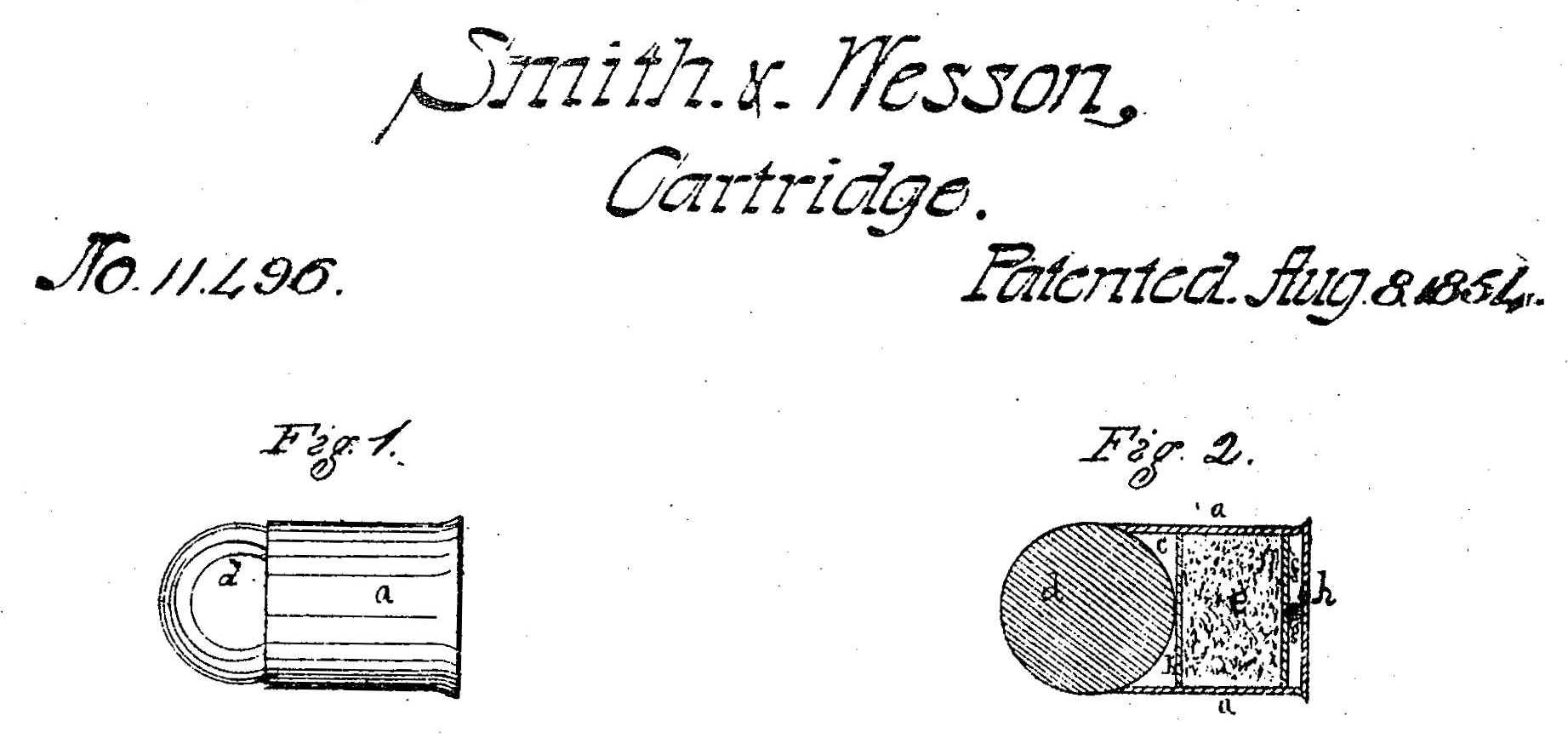 Flobert
cartridge that would result in the development of the .22 rim fire cartridge
that has continued in use with only a few changes up through today. At that
time, the partners were involved with manufacturing their poor selling
Volcanic firearm with its weak, undependable cartridges, and had no firearm
design that could use this new cartridge. By August of 1856, Wesson had
completed a model of a revolver that would use a rim fire cartridge which
was loaded from the rear of the cylinder. Flobert
cartridge that would result in the development of the .22 rim fire cartridge
that has continued in use with only a few changes up through today. At that
time, the partners were involved with manufacturing their poor selling
Volcanic firearm with its weak, undependable cartridges, and had no firearm
design that could use this new cartridge. By August of 1856, Wesson had
completed a model of a revolver that would use a rim fire cartridge which
was loaded from the rear of the cylinder.
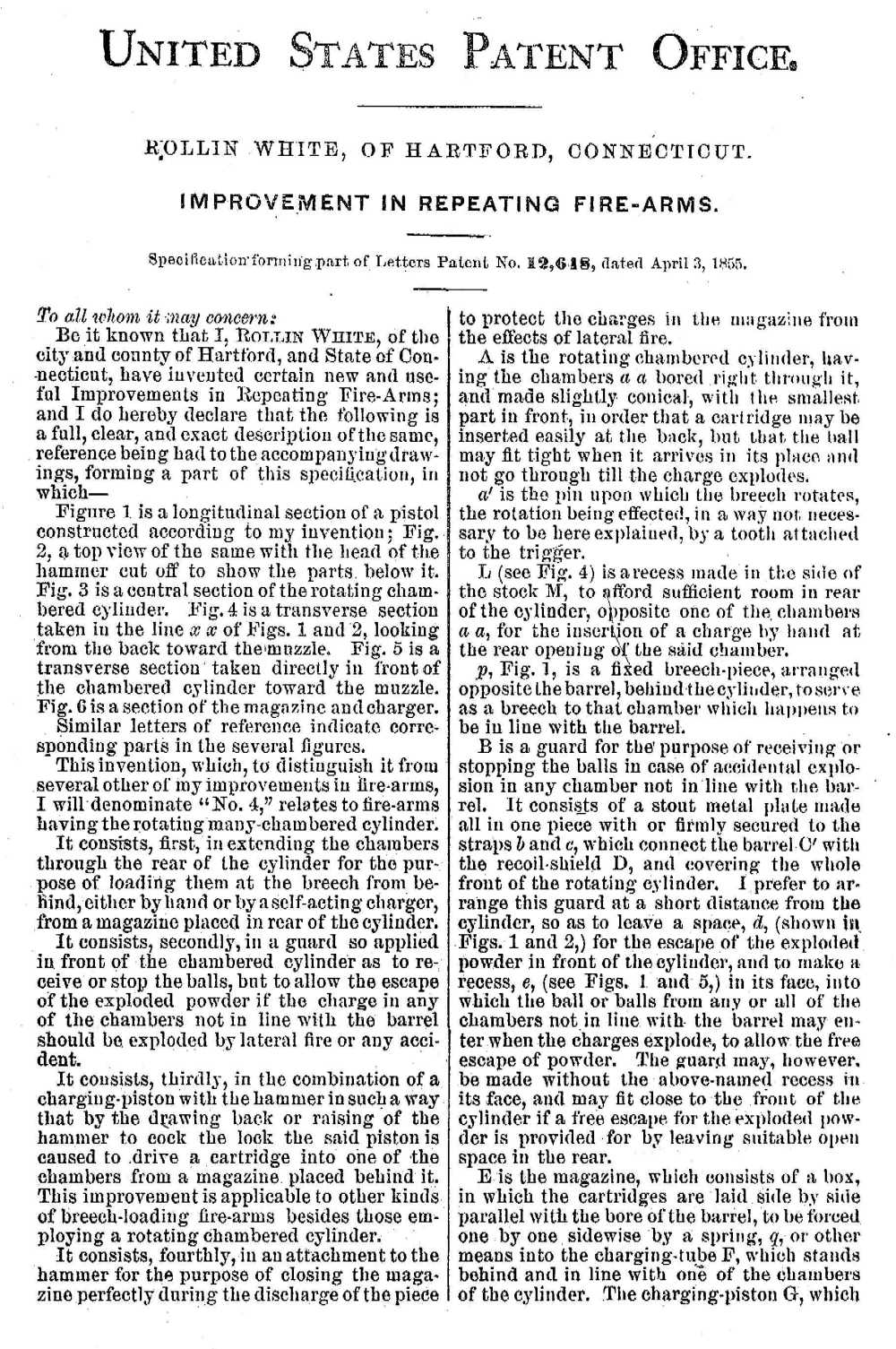 However,
on April 3, 1855 Rollin White was
issued a patent for a new revolver design. While the primary focus of
White's patent dealt with a reloading mechanism, the specifications state:
"extending the chambers of the rotating cylinder right through the rear of
the said cylinder for the purpose of enabling the said chambers to be
charged at the rear either by hand or by a self-acting charger", which meant
that no revolvers with bored through cylinders could be made in the United
States until White's patent expired on April 3, 1869. As their revolver
required a bored through cylinder, Smith & Wesson would need to make some
type of arrangement with White if they were However,
on April 3, 1855 Rollin White was
issued a patent for a new revolver design. While the primary focus of
White's patent dealt with a reloading mechanism, the specifications state:
"extending the chambers of the rotating cylinder right through the rear of
the said cylinder for the purpose of enabling the said chambers to be
charged at the rear either by hand or by a self-acting charger", which meant
that no revolvers with bored through cylinders could be made in the United
States until White's patent expired on April 3, 1869. As their revolver
required a bored through cylinder, Smith & Wesson would need to make some
type of arrangement with White if they were
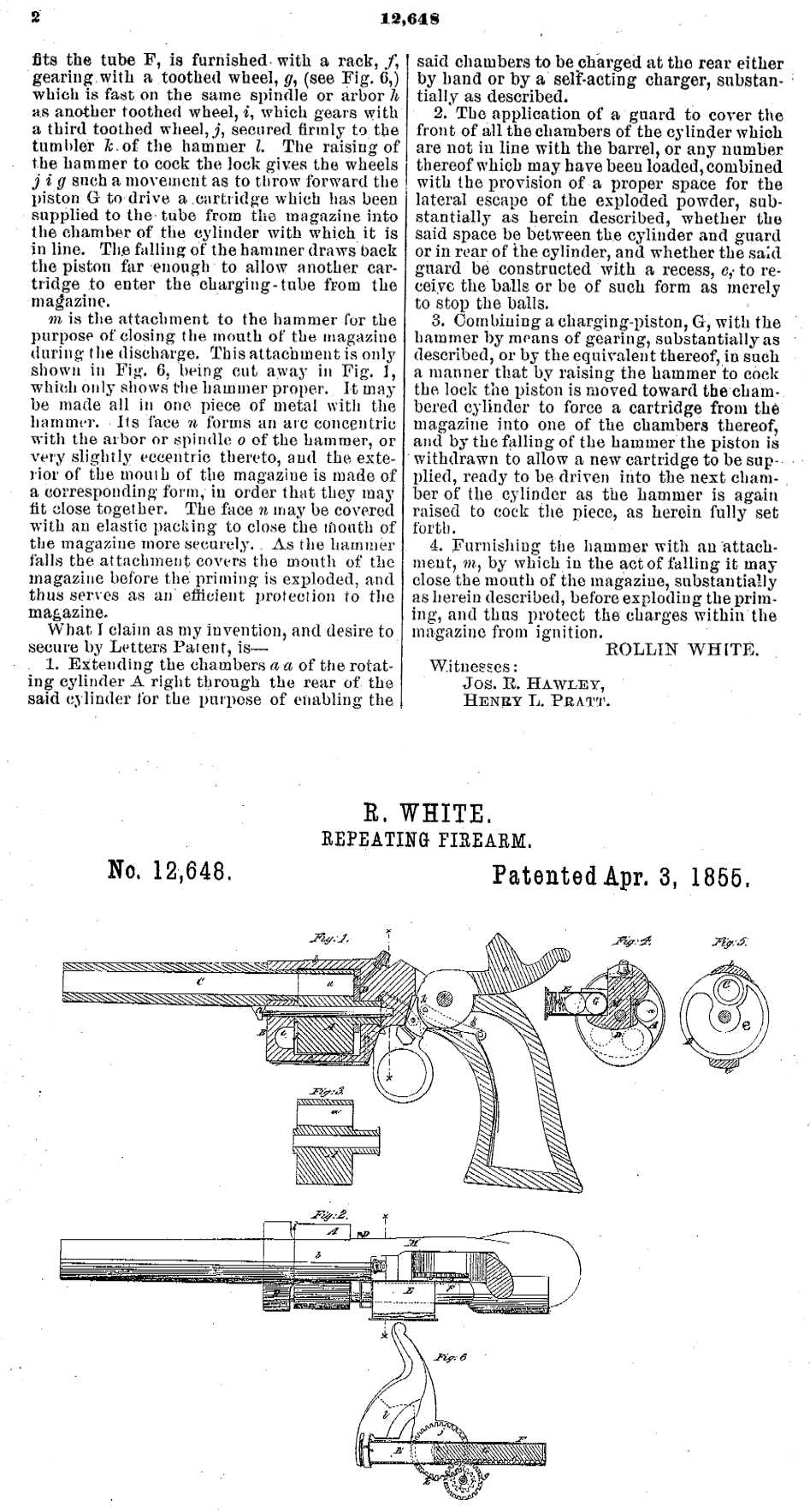 to
begin production of their revolver. On November 17th, 1856, Smith and Wesson
met with White and entered into an agreement to manufacture revolvers
using his cylinder design. This agreement granted them exclusive
manufacturing rights for revolvers having bored-through cylinders,
essentially preventing any other American firearms manufacturer from
producing a revolver using self contained metallic ammunition for the
duration of the patent. For the use of White's patent design, Smith & Wesson
would pay him 25 cents royalty for each revolver they produced while the
patent was in force. The following day, Smith and Wesson
made the initial entries in the cash book of their revolver-manufacturing
partnership, recording their cash holdings ($3,703.55), a payment to Rollin
White of $497.50, and the purchases of a lathe for $30. Over the next 12
months, White would receive just $1 in royalties, which must have given him
cause to wonder if he had hitched his wagon to the right star. He had no
need for concern, however, as it is estimated that he received royalty
payments for over 271,000 revolvers to
begin production of their revolver. On November 17th, 1856, Smith and Wesson
met with White and entered into an agreement to manufacture revolvers
using his cylinder design. This agreement granted them exclusive
manufacturing rights for revolvers having bored-through cylinders,
essentially preventing any other American firearms manufacturer from
producing a revolver using self contained metallic ammunition for the
duration of the patent. For the use of White's patent design, Smith & Wesson
would pay him 25 cents royalty for each revolver they produced while the
patent was in force. The following day, Smith and Wesson
made the initial entries in the cash book of their revolver-manufacturing
partnership, recording their cash holdings ($3,703.55), a payment to Rollin
White of $497.50, and the purchases of a lathe for $30. Over the next 12
months, White would receive just $1 in royalties, which must have given him
cause to wonder if he had hitched his wagon to the right star. He had no
need for concern, however, as it is estimated that he received royalty
payments for over 271,000 revolvers
It wasn't until early in 1858
that Smith & Wesson began production of their first revolver, the No. 1
(appropriately), a 7 shot .22 rim fire with a swing up barrel that allowed
the cylinder to be removed for reloading. This was a well-designed revolver,
and by May of 1860, over 11,000 had been produced. With the start of the
Civil War, the demand for their pistols was such that the company could not
keep up with it. As a result, other gun manufacturers began producing
revolvers that infringed on the Smith & Wesson controlled Rollin White
bored-through cylinder patent. These patent infringing companies included
Allen & Wheelock, Bacon Mfg Co, the Manhattan Fire Arms Mfg Co, Moore's
Patent Firearms Co, Luicious Pond, E. A Prescott, James Reid,
Springfield Arms Co, and James Warner , all anxious to cash in on this unmet
demand for cartridge revolvers and willing to risk the expense of litigation
with Smith & Wesson. These companies were sued by Smith & Wesson, and most
were forced to cease production of the infringing revolvers. However,
several including Bacon, Moore and Pond were allowed to continue production
under a licensing agreement which required that the revolvers be marked as
having been manufactured for Smith & Wesson, then sold to Smith & Wesson at
wholesale, who retailed them to meet some of the demand that their own
production facilities could not keep up with.
however, as it is estimated that he received royalty payments for over
271,000 revolvers
.
Ethan Allen was the first to
infringe on the Rollin White patent when he introduced the Allen & Wheelock
side hammer revolver in 1858, which was chambered for the standard .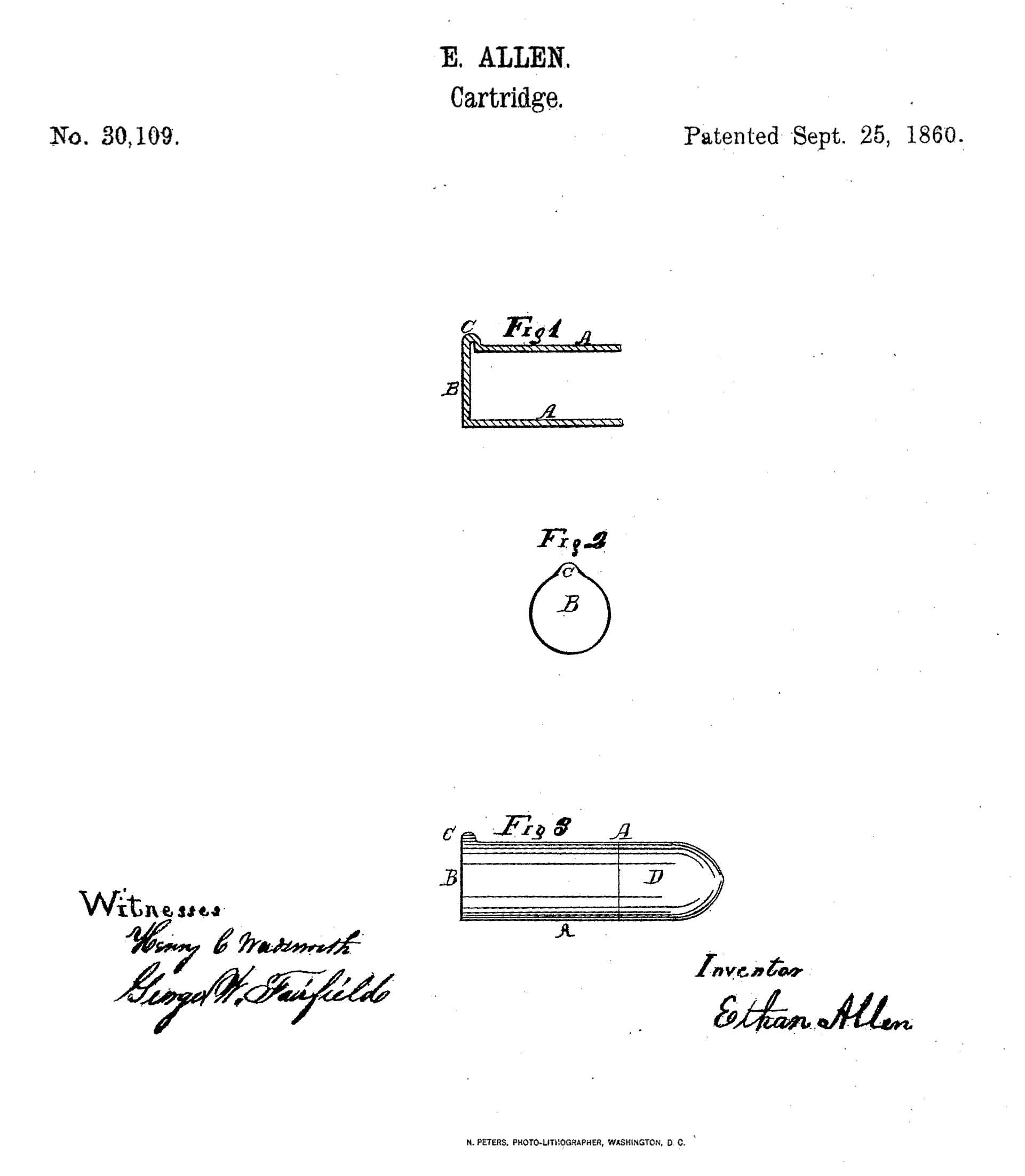 22
rim fire cartridge. Production was rather limited, with only about 1500 of
these having been made through 1861. On September 25, 1860, Allen was issued
a patent for an "improvement in metallic cartridges" for the lip fire
cartridge. His improvements, as listed in the patent specifications (see
below) included a reduction in the amount of priming required and a stronger
cartridge head, which was less likely to bulge or rupture on firing.
Production of lip fire revolvers commenced sometime in 1861, the first
(pocket) model in .32 caliber, followed by a second (Army) model in .44
caliber, a third (Navy) model in .36 caliber, and a fourth model in .25
caliber. Total production of all models of the lip fire revolvers combined
was less than 1,250. 22
rim fire cartridge. Production was rather limited, with only about 1500 of
these having been made through 1861. On September 25, 1860, Allen was issued
a patent for an "improvement in metallic cartridges" for the lip fire
cartridge. His improvements, as listed in the patent specifications (see
below) included a reduction in the amount of priming required and a stronger
cartridge head, which was less likely to bulge or rupture on firing.
Production of lip fire revolvers commenced sometime in 1861, the first
(pocket) model in .32 caliber, followed by a second (Army) model in .44
caliber, a third (Navy) model in .36 caliber, and a fourth model in .25
caliber. Total production of all models of the lip fire revolvers combined
was less than 1,250.
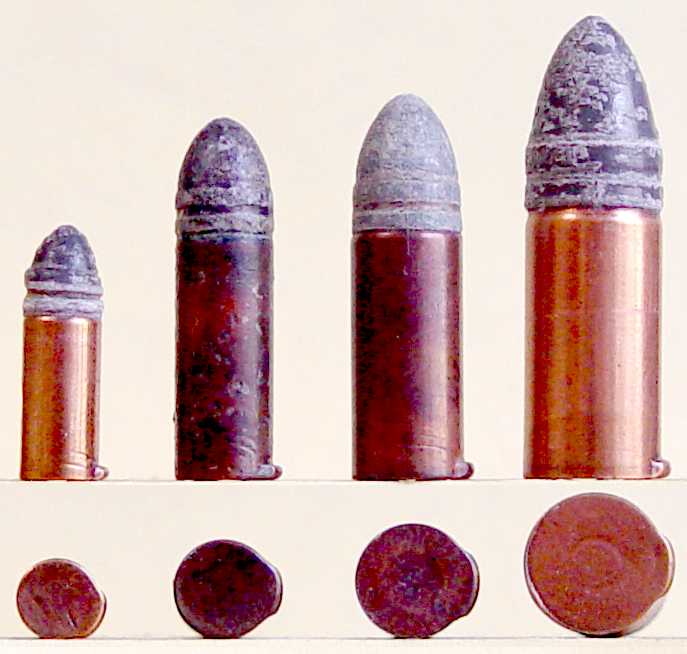 The
lip fire cartridges shown in this picture include the four calibers made -
.25, .32, .36, and .44. These were all made at Allen's cartridge
factory in Worchester, Massachusetts, established in 1858 and one of the
earliest in the United States. All sport the Allen-style pointed, heavy,
2-banded bullet. There is a .44 example with a shorter than
standard case but there are no other variations of these cartridges that I
am aware of. The little .25 caliber example shows three 'dashes' equally
spaced around the head that are also a characteristic often seen on Allen
cartridges. The
lip fire cartridges shown in this picture include the four calibers made -
.25, .32, .36, and .44. These were all made at Allen's cartridge
factory in Worchester, Massachusetts, established in 1858 and one of the
earliest in the United States. All sport the Allen-style pointed, heavy,
2-banded bullet. There is a .44 example with a shorter than
standard case but there are no other variations of these cartridges that I
am aware of. The little .25 caliber example shows three 'dashes' equally
spaced around the head that are also a characteristic often seen on Allen
cartridges.
..
.
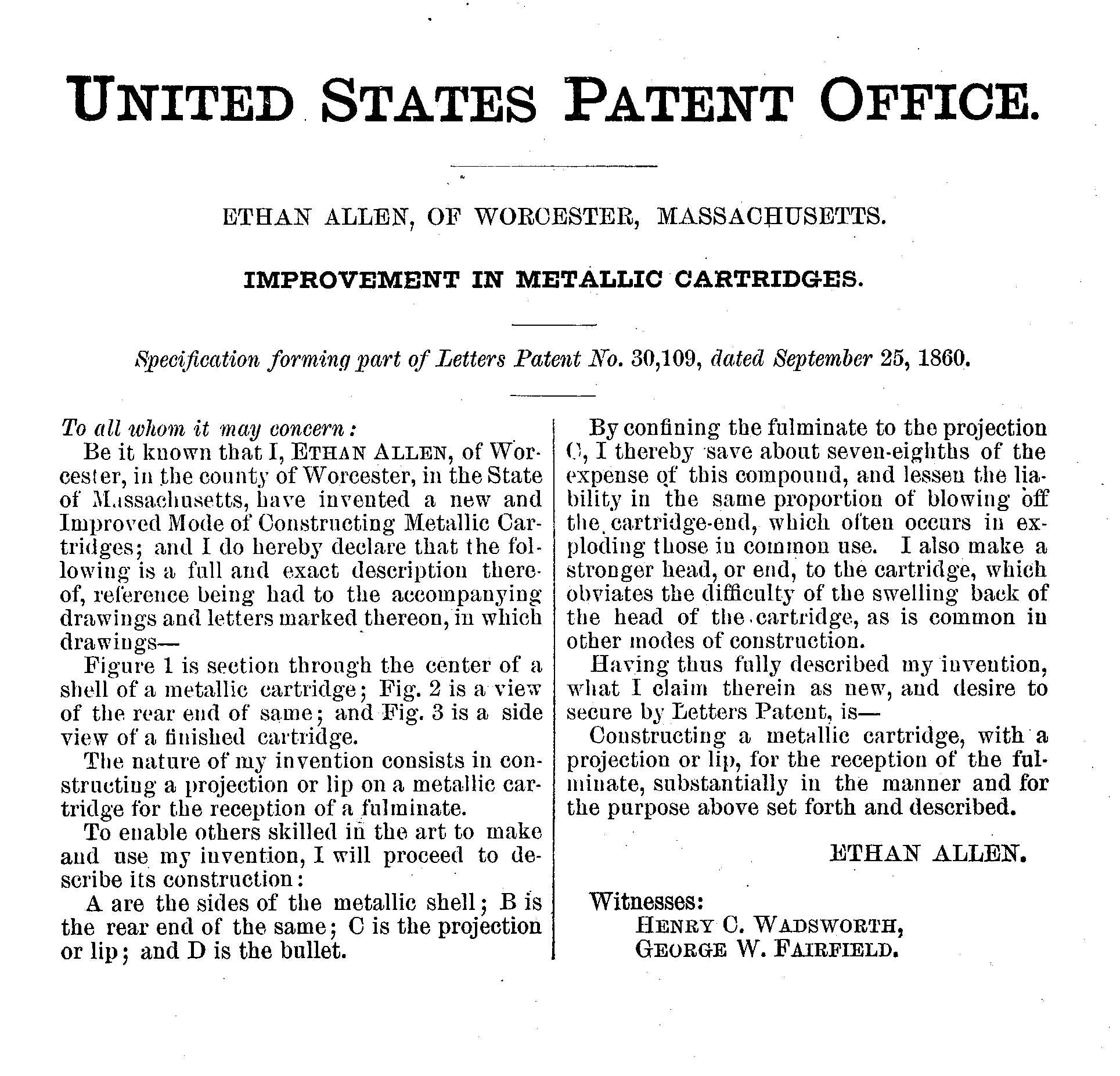
.
.
.
.
.
.
.
.
.
.
.
.
.
.
.
.
.
.
.
.
.
.
.
.
.
.
.
.
.
.
.
.
.
.
.
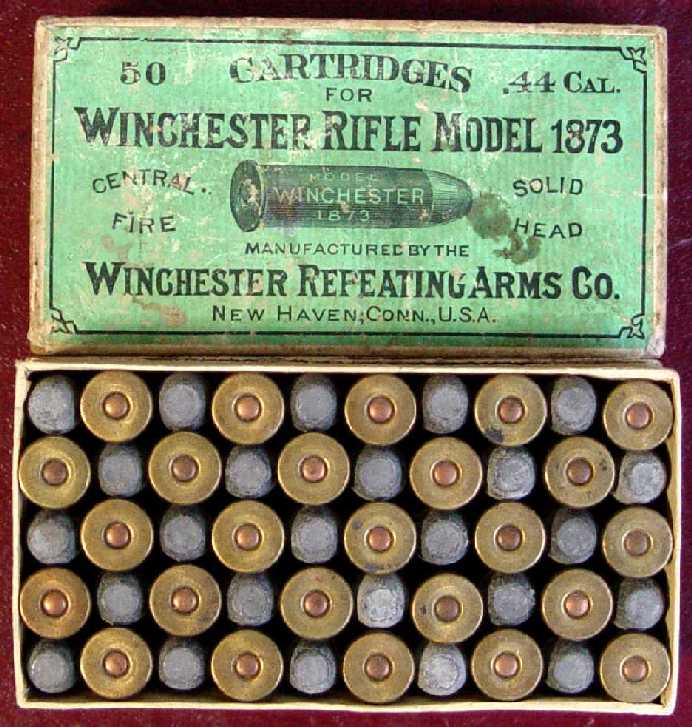
|

 Flobert
cartridge that would result in the development of the .22 rim fire cartridge
that has continued in use with only a few changes up through today. At that
time, the partners were involved with manufacturing their poor selling
Volcanic firearm with its weak, undependable cartridges, and had no firearm
design that could use this new cartridge. By August of 1856, Wesson had
completed a model of a revolver that would use a rim fire cartridge which
was loaded from the rear of the cylinder.
Flobert
cartridge that would result in the development of the .22 rim fire cartridge
that has continued in use with only a few changes up through today. At that
time, the partners were involved with manufacturing their poor selling
Volcanic firearm with its weak, undependable cartridges, and had no firearm
design that could use this new cartridge. By August of 1856, Wesson had
completed a model of a revolver that would use a rim fire cartridge which
was loaded from the rear of the cylinder. However,
on April 3, 1855 Rollin White was
issued a patent for a new revolver design. While the primary focus of
White's patent dealt with a reloading mechanism, the specifications state:
"extending the chambers of the rotating cylinder right through the rear of
the said cylinder for the purpose of enabling the said chambers to be
charged at the rear either by hand or by a self-acting charger", which meant
that no revolvers with bored through cylinders could be made in the United
States until White's patent expired on April 3, 1869. As their revolver
required a bored through cylinder, Smith & Wesson would need to make some
type of arrangement with White if they were
However,
on April 3, 1855 Rollin White was
issued a patent for a new revolver design. While the primary focus of
White's patent dealt with a reloading mechanism, the specifications state:
"extending the chambers of the rotating cylinder right through the rear of
the said cylinder for the purpose of enabling the said chambers to be
charged at the rear either by hand or by a self-acting charger", which meant
that no revolvers with bored through cylinders could be made in the United
States until White's patent expired on April 3, 1869. As their revolver
required a bored through cylinder, Smith & Wesson would need to make some
type of arrangement with White if they were
 to
begin production of their revolver. On November 17th, 1856, Smith and Wesson
met with White and entered into an agreement to manufacture revolvers
using his cylinder design. This agreement granted them exclusive
manufacturing rights for revolvers having bored-through cylinders,
essentially preventing any other American firearms manufacturer from
producing a revolver using self contained metallic ammunition for the
duration of the patent. For the use of White's patent design, Smith & Wesson
would pay him 25 cents royalty for each revolver they produced while the
patent was in force. The following day, Smith and Wesson
made the initial entries in the cash book of their revolver-manufacturing
partnership, recording their cash holdings ($3,703.55), a payment to Rollin
White of $497.50, and the purchases of a lathe for $30. Over the next 12
months, White would receive just $1 in royalties, which must have given him
cause to wonder if he had hitched his wagon to the right star. He had no
need for concern, however, as it is estimated that he received royalty
payments for over 271,000 revolvers
to
begin production of their revolver. On November 17th, 1856, Smith and Wesson
met with White and entered into an agreement to manufacture revolvers
using his cylinder design. This agreement granted them exclusive
manufacturing rights for revolvers having bored-through cylinders,
essentially preventing any other American firearms manufacturer from
producing a revolver using self contained metallic ammunition for the
duration of the patent. For the use of White's patent design, Smith & Wesson
would pay him 25 cents royalty for each revolver they produced while the
patent was in force. The following day, Smith and Wesson
made the initial entries in the cash book of their revolver-manufacturing
partnership, recording their cash holdings ($3,703.55), a payment to Rollin
White of $497.50, and the purchases of a lathe for $30. Over the next 12
months, White would receive just $1 in royalties, which must have given him
cause to wonder if he had hitched his wagon to the right star. He had no
need for concern, however, as it is estimated that he received royalty
payments for over 271,000 revolvers 22
rim fire cartridge. Production was rather limited, with only about 1500 of
these having been made through 1861. On September 25, 1860, Allen was issued
a patent for an "improvement in metallic cartridges" for the lip fire
cartridge. His improvements, as listed in the patent specifications (see
below) included a reduction in the amount of priming required and a stronger
cartridge head, which was less likely to bulge or rupture on firing.
Production of lip fire revolvers commenced sometime in 1861, the first
(pocket) model in .32 caliber, followed by a second (Army) model in .44
caliber, a third (Navy) model in .36 caliber, and a fourth model in .25
caliber. Total production of all models of the lip fire revolvers combined
was less than 1,250.
22
rim fire cartridge. Production was rather limited, with only about 1500 of
these having been made through 1861. On September 25, 1860, Allen was issued
a patent for an "improvement in metallic cartridges" for the lip fire
cartridge. His improvements, as listed in the patent specifications (see
below) included a reduction in the amount of priming required and a stronger
cartridge head, which was less likely to bulge or rupture on firing.
Production of lip fire revolvers commenced sometime in 1861, the first
(pocket) model in .32 caliber, followed by a second (Army) model in .44
caliber, a third (Navy) model in .36 caliber, and a fourth model in .25
caliber. Total production of all models of the lip fire revolvers combined
was less than 1,250. 